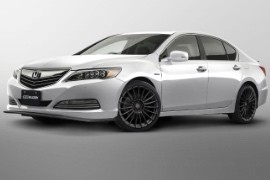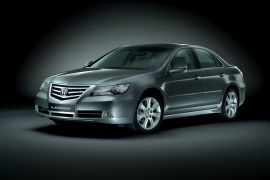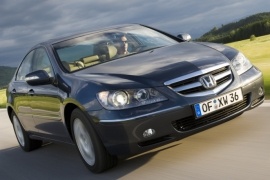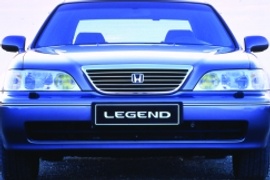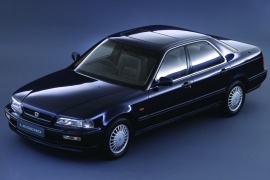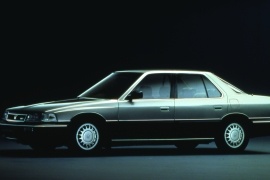HONDA Legend Sedan Models/Series Timeline, Specifications & Photos
First production year: 1987
Engines: Hybrid, Gasoline
While the American market demanded an executive premium car from Acura, the Japanese carmaker tried to sell it as a Honda in Japan and other Asian countries.
The experiment didn't work as well as the carmaker hoped for. It proved that Asian customers didn't share the American taste in cars. While in the U.S., a car had to offer cupholders, automatic transmission, and offer a comfortable ride on the highway. In other countries, those might not be on top of the list.
Honda introduced the fifth Legend generation in 2014 and only on selected markets. It showed a stylish, pentagonal grille that sported a thick horizontal chromed slat at the top and followed by two other slim slats. From its sides, the three-box executive sedan featured a cab-rearward design, with a pushed-back C-pillar above the rear axle and a short trunk.
Inside, a leather-clad interior proved a high level of taste for the Japanese carmaker. The dashboard featured curved lines combined in sharp angles for the instrument cluster and the infotainment screen placed above the center stack. A wide center console with wood trims and storage compartments separated the driver from its passenger. In the back, the carmaker installed a bench for three, with three headrests and seatbelts.
Under the hood, Honda offered the Legend's fifth-generation only with a hybrid system powered by a 3.5-liter V-6 powerplant and three electric motors.
Honda introduced the facelift for the fourth generation of its flagship model Legend at the 2008 Moscow Motor Show, preparing the car for the Euro 5 emission standards.
While in the U.S., the Acura RL was just at its second generation, the European Legend was already at the fourth. Yet, both cars were similar, and the different badges were used since the Japanese carmaker didn't want to introduce its premium brand on the Old Continent.
Honda looked like it didn't want to invest too much in the appearance of the facelifted version. Yet, it refreshed the headlights' look, which received sharper lines as opposed to the smoother ones from the non-facelifted version. In addition, the hood and the front grille were slightly reshaped to match the design of the headlamps. At the back, Honda also installed new taillights with an angular design that led to new quarter panels.
Inside, Honda kept the same layout for the cabin, although it improved a lot the comfort by adding a noise-canceling system. This uses the Bose infotainment to counter the low-frequency sounds with pitch, inaudible sounds. Moreover, the carmaker added new sound-deadening materials, which were lighter and as effective as those used before. Finally, an acoustic windshield improved the silence in the cabin.
For the drivetrain, Honda placed its bets on the same 3.7-liter V6 powerplant paired to a new, five-speed, automatic transmission developed in-house. It sent the power in all corners via an intelligent all-wheel drive system dubbed SH-AWD (Super-Handling AWD).
Honda launched the fourth generation of its flagship model, the Legend, in 2004 in Japan, and it reached other continents in 2005.
The Legend went through its biggest makeover in its history by introducing the all-wheel-drive system and its clever technologies. Honda put a big effort into the car, even though the results were far under the expectations.
It looked like a big barge on the road, but the U.S. market was considered a medium-sized vehicle. The sweeping, fluid lines, and narrow front end enhanced the dynamic look of the car. A V-shaped grille with one silver, horizontal slat that supported the H-badge poked ahead like a fist. In the lower bumper, another grille helped to cool the engine and the AC-compressor. In the back, the taillights were installed only on the quarter panels, and if that was good for the U.S. market, in the U.K. or Europe was not, since most of its competitors featured wider lights.
The interior was fitted as standard with wood-trims and leather, while the big screen for the infotainment unit was available as an option depending on the market and trim-level. Honda didn't want to go through the pains of various features and fitted the Legend with a fixed equipment, depending on the trim-level. There was ample room in the back for two adult passengers, with a center armrest that hosted cup-holders.
Unlike the other competitors in that segment, the Legend was available with only one engine-transmission configuration. The only option was a 3.5-liter V6 engine, paired to a 5-speed automatic transmission that sent the power to all corners via an intelligent system named SH-AWD (Super Handling all-wheel-drive).
Honda introduced the third generation of its flagship model, the Legend, in 1996 as a sedan-only body version and aimed directly to the Mercedes-Benz E-Class.
The Japanese carmaker tried its best to make an executive sedan able to offer a comfortable ride and good performances. It was its key-vehicle to enter in the premium segment, but it couldn't match the engine choice offered by the European carmakers.
While its look resembled its predecessor, the third generation of the Legend was a new vehicle. It showed the same flat-horizontal lines on the hood and trunk lid. Other European carmakers might have inspired it, but the front grille and the headlights were similar to the Legend's second generation. Its body-colored bumpers and side moldings made it look like an executive vehicle.
Inside, there was enough room for five adult-sized occupants. Its center tunnel was narrow and short. The wide heated seats with leather upholstery were designed for comfort. In the instrument cluster, Honda installed three binocular-style dials, where the speedometer took center stage while the tachometer was on the left. Its wood-trims on the dashboard and the ergonomic center stack layout made the car looks more upmarket.
Unfortunately, Honda offered the 1996 Legend with only one engine option, a 3.5-liter V-6 that provided 205 hp. It was paired as standard to a four-speed automatic transmission.
Honda introduced the second generation of the Legend sedan in 1990 as its flagship model. It was a consistent upgrade over its predecessor in terms of performance and safety.
The Legend aimed directly at the German premium carmakers. Honda put every piece of technology it had in that model. Unfortunately, it only had one engine choice, and that, along with a mild economic crisis at the beginning of the '90s, stalled the sales. Nevertheless, it was a highly appreciated car in its class.
With its narrow headlights, flat hood, and streamlined cabin, the Legend was a great design exercise for the Japanese carmaker performed by Yusuke Saitoh. The frameless door windows and the narrow window area made it look like a four-door coupe or a faux-coupe. The headlights were taller than on its predecessor. According to the U.S. regulations, the designers installed the taillights on fixed body panels in the back.
Honda offered the Legend in two trim-levels: Beta as a base model and Alpha for the full version. The carmaker even installed a navigation system on the vehicle, which was a very unusual feature for those times. Its comfortable, heated leather seats and the wood-trims on the dashboard and door panels made the car looks premium. In the U.S., the carmaker sold the Legend under the Acura brand, Honda's premium brand.
Under the hood, the carmaker installed a 3.2-liter V6 engine paired with a 5-speed manual or a 4-speed automatic transmission. The all-wheel independent suspension and the long-wheelbase made the car comfortable on the road. From the safety point of view, Honda installed dual airbags as standard.
Honda introduced the Legend on its home market in 1985 and tested the car in the real world before crossing the pond and sell it in the U.S.
Available as a sedan and a coupe, it was the car that started the Acura brand, and it combined luxury, comfort, performance, and a reasonable price into one vehicle. The Japanese carmaker took its competitors by surprise and made it sell more than 55.000 units in the second year after it entered the U.S. More importantly, the coupe was available with a more powerful engine than the sedan.
It was wedged-styled and with rectangular headlights. The sculptured fenders left the impression of a wider track that helped the car being more planted to the road. It wasn't more exhaustive, but thanks to its double-wishbone suspension, it really was better in cornering than most of the cars from its segment. Moreover, it featured frameless windows.
Inside, both versions provided more comfort and a good interior room. The rear seats provided adequate room for the four-door sedan and a decent amount for the coupe. Honda installed most of the interior features as standard. There were only two options for the car: exterior color and transmission.
Under the hood, the Japanese Legend featured a 2.0-liter V-6 engine fed by a variable turbocharger unit (VTG), which was way ahead of its times. The U.S. cousin featured a 2.5-liter V-6 for the sedan and a 2.7-liter for the coupe.
